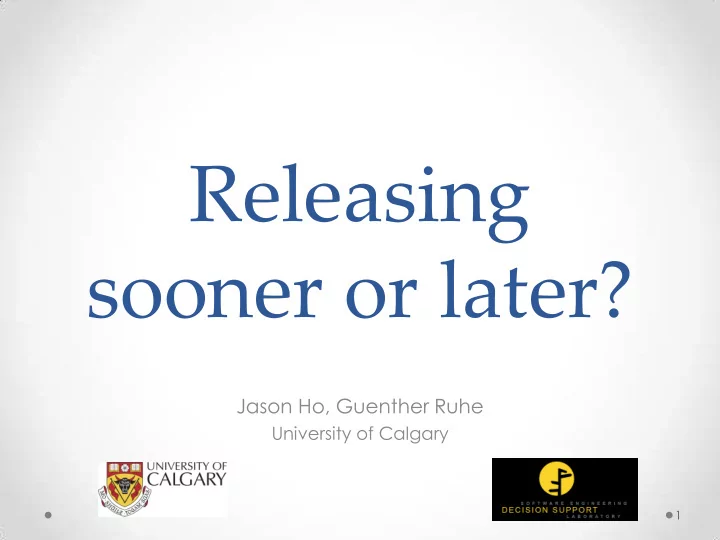

Releasing sooner or later? Jason Ho, Guenther Ruhe University of Calgary 1
Outline Problem Definiton • Release Planning Problem o When-to-release Problem (W2RP) o Research Questions o Innovations o Approach • Modeling o Effort re-allocation o Trade off Solutions o Evaluation - Case Study • Limitations & Outlooks • References • Q & A • 2
Release Planning Problem 3
When-to-release (W2RP) RQ1: Given a specific release date , by varying around a • duration, how can we identify an optimized release date? RQ2: What is the trade-off between the value (stakeholders’ • satisfaction) and the assured quality (reliability) of the release plan? 4
Contributions • As an independent tool-plugin: W2RP can be used as-is with existing processes and existing tools o W2RP presents instant and interactive what-if solutions o • During Strategic Planning Different alternatives for when-to-release date with predictable outcomes o • During Operational Execution As the project progresses, more defect data will be available increase o in accuracy of the prediction model of quality Re-planning potential • Challenges: Complexity of assigning the right resources to the right task at the right o time Trade-off between different criteria while maintain quality and value o benchmark 5
Modeling • Time: RD: Targeted time to be released by stakeholders (calendar dates) o RD ± T: The duration in which the release date can be varied to find the o optimized release time • Values: Measured by Customers’ weighted satisfaction score o As each feature consumes resources, values is affected by capacity of o the resources assigned to that feature set. • Quality: Defined by certainty level of successful transactions after releases o Quality is assured by investing effort for testing (Cost of Quality), which o comprises of Cost of Conformance (effort for designing test cases) and Cost of Lack of Conformance (effort for fixing bugs) CoQ = CoC + CoLC As testing consumes resources, quality is affected by capacity o 6
Approach 1. W2RP Request 1. W2RP Request Existing Plans Existing Plans 2. Feature set F1 and 2. Feature set F1 and Baseline plan for Baseline plan for Re-plan requests Release Date RD1 Release Date RD1 3. Local variation of Release parameters 3. Local variation of Release parameters 3.1. Reduce testing effort to maximize 3.1. Reduce testing effort to maximize values through new features values through new features 3.2. Reduce coding effort to maximize 3.2. Reduce coding effort to maximize 5. Candidate plans quality of existing features quality of existing features 3.3. Balance testing and 3.3. Balance testing and implementation to reduce timeline implementation to reduce timeline 4. Global variation of release date 4. Global variation of release date 7. Select 7. Select 6. Determine trade-off solutions 6. Determine trade-off solutions Final Plans Final Plans 7
Effort Re-allocation • Plan stability Changes in timeline will o only affect more recent features • Priority: Effort in building o new/important functionalities Effort in testing o built/existing functionalities Balanced for the best o timeline 8
Evaluation - Case Study • We evaluate the approach using a Case study from a real life technical project • Objectives: Evaluate Optimization approach o Collect data on potential Trade-off solutions o • Case set up: 9
Case-study – Trade-off Solutions Potential trade-off • solutions Maximize Total Release Values o TRV(F i ) Maximize Total Release o Quality TRQ(F i ) Minimize Time to release RD i o 10
Limitations & Outlook • Limitations Reliant on extensive data of o number of test cases, defect rate, and fix rate which may not be well-defined in real-life, complex projects. Do not consider fixing and o revising of requirements and design. • Future works: Integration to existing tools o Consider different optimization o approaches for re-allocation Conduct more in-depth analysis o and evaluations 11
References [1] B. Boehm, V. R. Basili. "Defect Reduction Top 10 List ”, Computer (2001), pp. 135- • 137. [2] J. Campanella, "Principles of Quality Costs: Principles, Implementation and Use, • "ASQ Quality Press, 1999. [3] J . M. Elroy, G. Ruhe, “When -to-release decisions for features with time- • dependent value functions”, Requirements engineering 15.3 337-358, 2010. [4] B.H . Far “Software Reliability Models”, Dependability & Reliability of Software • Systems, Chapter 6, Lecture Notes, 2012. [5] Polat, G., Arditi, D., & Mungen , U. “Simulation -based decision support system for • economical supply chain management of rebar”. Journal of construction engineering and management , 133(1), 29-39, 2007. [6] J. Ho, G. Ruhe, “ Releasing sooner or later: An optimization approach and its • case study evaluation”, Unpublished, IEEE, 2013. [7] R. Lai, G. Mohit, and P. K. Kapur. "A Study of When to Release a Software • Product from the Perspective of Software Reliability Models." Journal of Software 6 (2011), pp. 651-661. [8] M. Przepiora , “A Hybrid Release Planning Method for Accommodating • Advanced Feature Dependencies”, Department Of Computer Science, University of Calgary (Master Thesis), 2012. [9] G. Ruhe, “Product Release Planning: Methods, Tools and Applications”, • Calgary, AB, Canada: CRC Press, Chapter 8.3, pp. 157-160, & Chapter 10.4, pp. 221-227, 2010. [10] L. Zawadzki & T. Orlova , “Building and Using a Defect Prediction Model”. • Chicago Software Process Improvement Network, Feb, 2012. 12
Recommend
More recommend